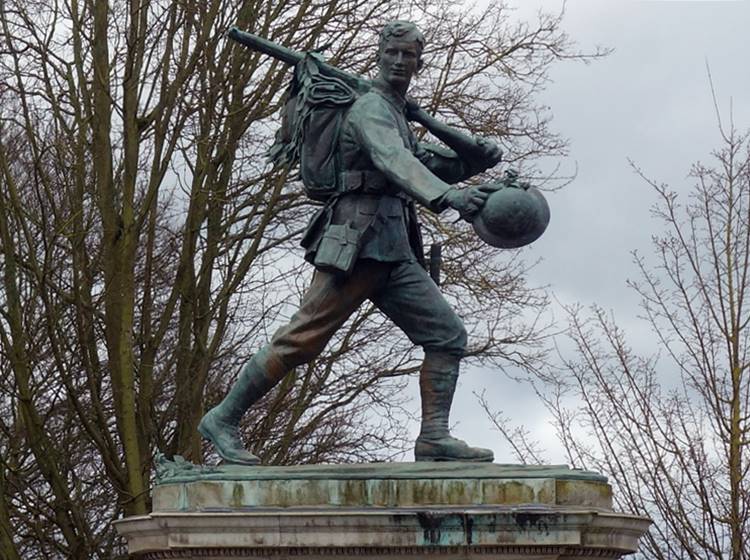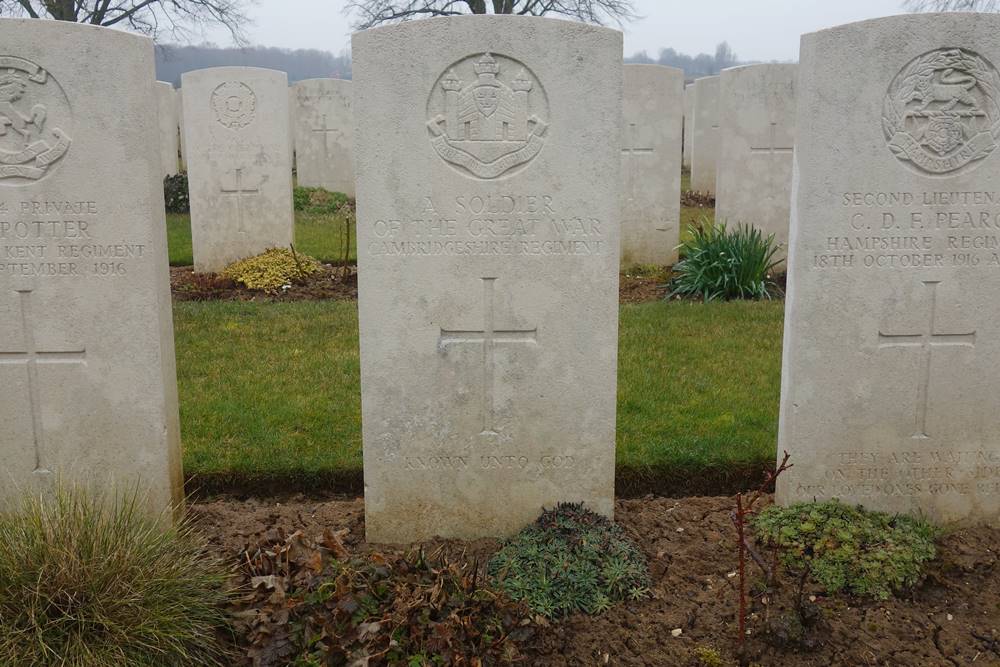This article looks at the Cambridgeshire Regiment during the First World War and will help you research the soldiers who served with it. This page is one of my guides to help you research soldiers who served in the British Army:
The Cambridgeshire Regiment in the First World War
The Cambridgeshire Regiment was a Territorial Force regiment which prior to the outbreak of war consisted of a single battalion. This battalion had its headquarters at Cambridge where it was part of the East Midland Brigade of the East Anglian Division. During the First World War, three other battalions were raised but only the 1st Battalion saw active service. The Commonwealth War Graves Commission recorded 852 dead for the Cambridgeshire Regiment between 4 August 1914 and 11 November 1918.
1/1st Battalion The Cambridgeshire Regiment
The 1st Battalion had its Headquarters at Cambridge where it was serving as part of the East Midland Brigade of the East Anglian Division. After embodiment, the Battalion moved to Romford, then Long Melford, Stowlandtoft, and to Bury St Edmonds. After the raising of its second-line in September 1914, the Battalion became the 1/1st Battalion, though it was often still referred to as the 1st Battalion. In February 1915, the Battalion left the Division and landed in France, where it joined the 82nd Brigade of the 27th Division. On 15 November 1915, the Battalion became VII Corps Troops and then a Training Battalion for 3rd Army School at Flixecourt. On 29 February 1916, the Battalion joined the 118th Brigade of the 39th Division. On 9 May 1918, the Battalion joined the 35th Brigade of the 12th Division and later absorbed 11 officers and 408 other ranks from the 7th Battalion The Suffolk Regiment.
2/1st Battalion The Cambridgeshire Regiment
The 2/1st Battalion was formed at Cambridge in September 1914 as the Regiment’s second-line. In December 1914, the Battalion moved to Peterborough where it joined the 207th Brigade of the 69th Division. In February 1915, the Battalion briefly joined the East Midland Brigade of the East Anglian Division at Bury St Edmonds, taking the place of the 1/1st Battalion. In April 1915, the Battalion rejoined the 207th Brigade which was still stationed at Peterborough. In June, the Battalion moved to Newmarket and in November helped to form the 4/1st Battalion. In June 1916, the Battalion moved to Harrogate, then to Marton Hall in October and Carburton in May 1917. On 8 October 1917, the Battalion joined the 200th Brigade of the 67th Division at Canterbury. In either February or March 1918, the Battalion was disbanded.
3/1st Battalion The Cambridgeshire Regiment
The 3/1st Battalion was formed at Cambridge on 17 February 1915 and moved to Windsor in August. In October 1915, the Battalion moved to Halton Park where on 8 April 1916, it became the 1st (Reserve) Battalion. On 23 April 1917, the Battalion was amalgamated with the 4th (Reserve) Battalion The Suffolk Regiment to form the Cambs and Suffolk Reserve Battalion The Suffolk Regiment. In August 1917, the Battalion moved to Crowborough and then to Hastings around August 1918.
4/1st Battalion The Cambridgeshire Regiment
The 4/1st Battalion was formed at Newmarket on 6 November 1915 by the 2/1st and 3/1st Battalions. After formation, the Battalion joined the 208th Brigade of the 69th Division at Bury St Edmonds. In either May or June 1916, the Battalion moved to Harrogate and then to Doncaster in October. In April 1917, the 4/1st Battalion moved to Thoresby, Nottinghamshire where it was disbanded in July 1917.
The Cambridgeshire War Memorial at Cambridge.
Researching Soldiers who Served in the Cambridgeshire Regiment
I’d recommend starting off by looking through my generic guides to researching soldiers, especially those on finding service and medal records. You’ll encounter a lot of military jargon and I have a page on abbreviations and acronyms. The two most important sources for researching the Regiment during the war, are its war diaries and The Cambridgeshires, 1914 to 1919 by Brigadier-General E. Riddell and Colonel M. C. Clayton. Both resources are discussed below. If you’re researching a casualty, the Cambridge Independent Press and the Cambridge Illustrated Journal are good newspapers to search with the latter containing a lot of photographs of soldiers. The Cambridge Independent Press has been digitized and can be searched on Findmypast.
Officers: The most important document is an officer’s service record but not all of them have survived. If an officer left the British Army prior to April 1922, then if the record has survived it will be held at the National Archives in London. When “Cambridgeshire Regiment” is searched, 196 files are shown but there will be others to officers who had left the Regiment. If an officer served past April 1922, then their record will still be held by the Ministry of Defence and you’ll have to apply for a photocopy: Ordering a Service Record from the MOD. Both the war diaries and regimental history are full of the names of officers so these should be checked. For promotion dates make sure you check the London Gazette and Army Lists. Local newspapers are a good resource for information about officers, especially if they won a gallantry award or became a casualty.
This photograph of Captain Alec Johnson MC of the 1/1st Battalion The Cambridgeshire Regiment was published in The Sphere after he was killed in action on 18 September 1918. Captain Johnson is buried at Epehy Wood Farm Cemetery, Epehy. The Sphere is an excellent newspaper to search if you’re looking for a photograph of an officer who died during the war. Fortunately, the newspaper has been digitized and can be searched on Findmypast. The cap badge of the Cambridgeshire Regiment was Cambridgeshire Castle with the coat of arms of Ely below the centre turret. On the collar badge, which Captain Johnson is wearing, the coat of arms was on the central turret.
Other ranks: The most important document to research a soldier is their service record but many were destroyed in the Blitz. If a soldier continued to serve past January 1921, then their service record should be held by the Ministry of Defence and you’ll have to apply for a copy. This is a straightforward process but does take some time. Approximately 10,000 soldiers served with the 1/1st Battalion on the Western Front and even if no service record survives for them, you’ll have at least two medal records to consult. About 4,000 casualties were sustained by the 1/1st Battalion, so casualty lists are worth checking and Soldiers Died in the Great War.
Regimental History of the Cambridgeshire Regiment
There is a good and readable regimental history, The Cambridgeshires, 1914 to 1919 by Brigadier-General E. Riddell and Colonel M. C. Clayton which was published by Bowes and Bowes in 1934. Fortunately, the book has been reprinted by the Naval and Military as original copies are quite expensive. I’d highly recommend combining this book with the Regiment’s war diaries. Photographs appear throughout the book, three maps of the Ypres Salient, The Somme and Vimy Ridge as well as an index. There are four appendices giving the Regiment’s battle honours, a summary of honours awarded (no names), the number of casualties sustained and a brief account of the Depot, 2/1st, 3/1st and 62nd Provisional Battalions as well as a few paragraphs on the Volunteer Force.
War Diaries of the Cambridgeshire Regiment
A war diary was written by an officer of a unit and recorded its location and activities. They often contain appendices in the form of orders, battle reports and maps. They are held at the National Archives in London and the 1/1st Battalion’s have been digitized and can be downloaded for a small fee by clicking the links below. The fourth war diary for the 2/1st Battalion can only be viewed at the National Archives.
1/1st Battalion The Cambridgeshire Regiment
- Date: 01 March – 30 November 1915
- 82nd Brigade, 27th Division
- Reference: WO 95/2266/1
- Notes: There’s not much to report regarding the Battalion’s activities during this period but the entries still provide good detail. There are no appendices.
- Date: 01 December 1915 – 30 April 1918
- 118th Brigade, 39th Division
- Reference: WO 95/2590/1
- Notes: A good war diary with a variety of appendices including one recording the Operations of the Cambridgeshire Regiment between 14 and 16 October 1916 along with two maps, reports on raids, opening day of the Third Battle of Ypres on 31 July 1917.
- Date: 01 May 1918 – 10 March 1919
- 35th Brigade, 12th Division
- Reference: WO 95/1850/2
- Notes: A good war diary prior to Armistice with a variety of appendices including a report on Operations on 8 and 9 August 1918.
2/1st Battalion The Cambridgeshire Regiment
- Date: 13 October 1915 – 2 March 1916
- 207th Brigade, 69th Division
- Reference: WO 95/5464
- Notes: This is a typical diary for a unit serving in Britain with brief entries. There are no appendices.
The headstone of an unknown soldier of the Cambridgeshire Regiment, buried in the Gommecourt British Cemetery No.2, Hebuterne. Nearly fifty soldiers of the Regiment are commemorated on the Thiepval Memorial to the missing of the Somme. This unknown soldier is one of them and his body was recovered from the spot marked by the black dot below. From the location his body was recovered from, the soldier was killed during the attack on the Schwaben Redoubt on 14 October 1916 close to where he was found. The Regiment suffered fifty dead during the attack and of this number, twenty-seven have no known grave.




